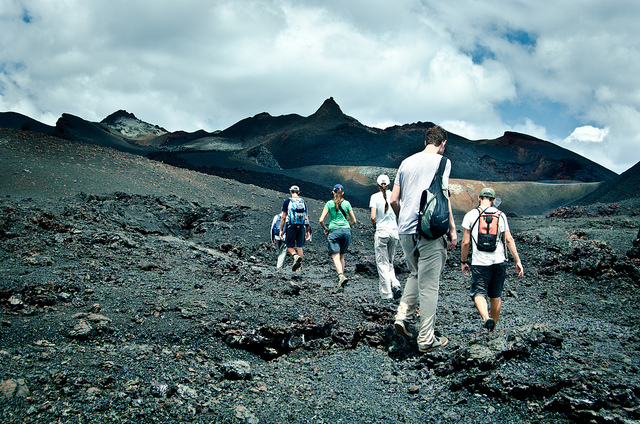Editor’s note: When my wife and I spent 6 months in South America as part of our round the world trip, the Galapagos was near the top of our wish-list. But as soon as we started researching, we quickly realized that there was no way our budget could afford it. When Vickie Lillo contacted me a couple months ago and told me how much her family of three spent on their 14 day trip to the Galapagos, airfare from the US included ($5000USD total), I asked her to tell her story and break down the costs.
For years I’d been staring at glossy magazine photos of glamorous cruise ships plying the waters of the Galápagos. For years, I’d been staring at those glamorous prices too. Exorbitant…out of reach. I was very disappointed. There had to be a way for ordinary folk to visit the islands; after all, the majority of the planet wasn’t born with a silver spoon in its mouth.
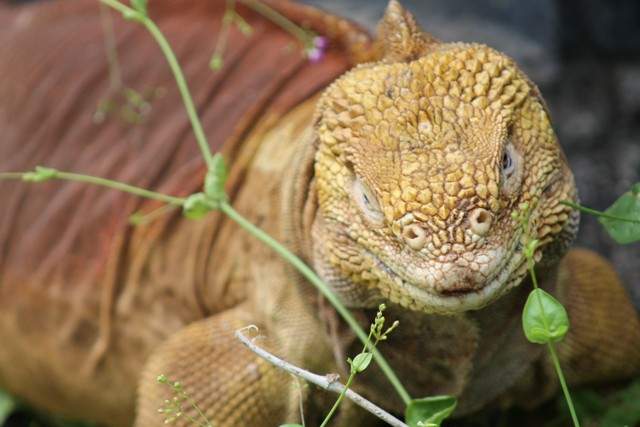
I tiptoed closer to the marine iguana, basking carefree in the hot, afternoon sun. He was languishing half in the sand, half on a patch of beach grass. He paid no attention at all to my approach. The spines on his back didn’t bristle…he didn’t shrink from my approach…in fact, he still sported that same unconcerned expression on his face that almost passed for a smile.
That was the first glimpse of the Galápagos’ colorful palette, which shimmered like paint splashed across the land and the sea in a kaleidoscope of ever-changing hues. Turquoise waters of the Pacific, the brilliant greens of the wetlands–they provided the perfect backdrop for the golden faces of the land iguanas, the bright-blue feet of the boobies, and the scarlet throat sacks of the fragatas(frigate birds). The colors of the rainbow were in full bloom here, in Darwin’s evolutionary paradise.
The dream realized
A decade ago, I had clipped an article from a prominent periodical, Arthur Frommer’s Budget Travel, detailing a land-based approach. I gleaned that article from my files and renewed seeds of hope were spawned. A planner by nature, I was bound-and-determined to find an affordable way to garner that top spot on my bucket list. I wanted to swim with the sea lions. I wanted to view the giant tortoises, roaming free in the highlands, in their natural habitat. Mostly, I wanted to get up-close-and-personal with the Galápagos’ wild and exotic birds.
Thus began six months of heavy duty web surfing and poring through pages of travel reviews to come up with a do-able 2-week itinerary within the constraints of our limited finances–no more than $5000 (all expenses are broken down at the end of the article). We flew out of Miami, for just a tad over two grand, and were on our way to Santa Cruz, with a little less than $3000 in our pockets and a schedule in hand.
For us, with time being so limited and precious, we didn’t intend to waste one minute of it expecting a deal to come our way. Instead, I came up with some deals of my own.
Though jam packed with activities, this year’s itinerary actually factored in some leisure time between adventures. That meant I would be able to return to work without having to “recover” from my vacation. Now, I understand that some travelers like to be more spontaneous, and if you want to wait around for the hope that a last-minute, rock bottom-priced cruise might surface, that’s fine. But for us, with time being so limited and precious, we didn’t intend to waste one minute of it expecting a deal to come our way. Instead, I came up with some deals of my own.
Planning – accommodation and food
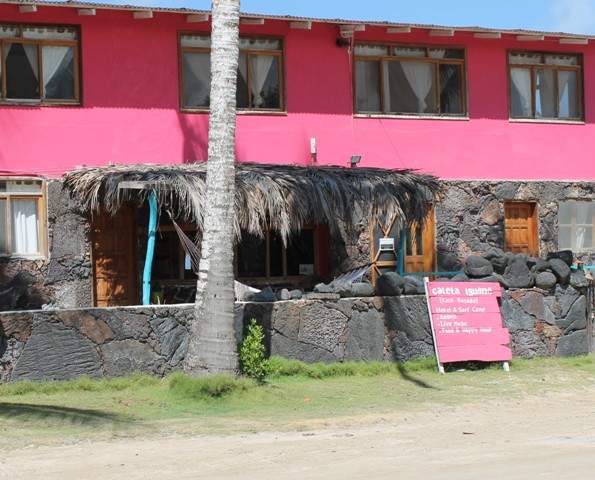
With the help of an online travel agent who actually lives on the island, we were able to rent an apartment for the week we spent on Santa Cruz. Third floor, next to Almacen d’Pily, 45 stairs to the room…for $40/night.With our own kitchen, we took advantage of the local bakeries and started our mornings with fresh, right-out-of-the-oven rolls and croissants ($0.25/piece), heaped with manjar (caramel sauce). We stocked the refrigerator with inexpensive fresh fruits–oranges, guavas, papayas, maracuyá (passion fruit) – and snacked on salted plantains.
[social]
For our occasional lunches eaten out and dinner fare, we ate like the locals, on Charles Binford Street. By day, the cobblestone thru-way was open to island traffic – taxis, motorcycles, scooters, and bikes. Around 6pm, though, as the stars began to come out, so did the tables and chairs from the restaurants lining both sides of the street. The charcoal grills fired up and all along the sidewalks, and you’d see the glint of red-hot coals. Occasionally, you’d hear the whir of a hair dryer used to fan the flames. You could gorge on a heaping plate of fried rice embellished with seafood at Chifa Asia or eat till you burst for $5-7/person at Servi Sabroson. The staple of the Galápaguero diet seems to be fish, mounds of rice and menestra (beans), fried potatoes, and a smidgeon of salad. Heavy on the carbs…light on the wallet. For the true seafood lover, there are maremoto or encebollada soups at El Pulpo Cevicheria for five bucks.
The wildlife

Thinking back fondly on our two-week stay in the archipelago, I deftly sidestepped another monster marine iguana on the trail back from the lagoon. A prehistoric-looking lizard of enormous proportions. I recalled the first time we had encountered the iguanas marinos, strolling along the quay in downtown Santa Cruz. They were everywhere: snoozing on the boardwalk along the shore or scurrying into an outcropping of mangrove trees. We even spied a thrifty youngster peeking out of the home he’d created in a cluster of metal mailboxes.
That was one of our favorite places to hang out–at the wharf. Morning and afternoon, the pescadores (fishermen) would haul in the day’s catch, gutting the pez espada (swordfish) and albacore right there on the concrete deck. Besides the tourists and the locals, hovering to purchase the fresh fish at its unbelievable $2/kilo price (2.2 lbs.), the resident birdlife would be lining up too, ready to nab a stray speck of entrails. Brown pelicans would be roosting in the manglares (mangroves), hoping for a string of bloody innards.. A red-eyed swallow-tail gull might be lurking in the shadows of the “butchering” area, patient as a lioness waiting for prey. On occasion, an inquisitive sea lion in search of a fishy snack might flop onto the dock…slithering across the wet, slippery concrete. Free entertainment.
There were many such moments in the Galápagos – opportunities to interact with the native wildlife that didn’t cost a nickel. At the Charles Darwin Research Station, we meandered along the walkways of the turtle corrals, checking out tortugas in the full range of sizes – from little miniatures to the Goliaths of the reptile kingdom. They languished in the shade of Opuntia cactus trees, while in another enclosure, gilded land iguanas feasted on stalks of edible greenery.
On the neighboring island of Isabela, accessed by a $30 three-hour ferry ride, La Crianza offered another free glimpse into the life cycle of the giants. Spying a poor little turtle struggling on his back, trying to right himself, we drew it to the attention of a caretaker. Grateful, the National Park Service worker immediately stepped into the corral, amongst the throngs of tortoises. As if on cue, there was an enormous whooshing sound…the resonance of several dozen heads and pairs of legs being suctioned like a vacuum cleaner inside their bony shells. Except for that one, still floundering upside down. On the trail to the breeding center, you’ll pass La Poza de Las Diablas (Devil’s Pond), where you’ll see Galápagos pintail ducks and elegant flamingos. Watch a marine iguana leap from the bridge and swim, alligator-like, through the red-tainted water.
Isabela
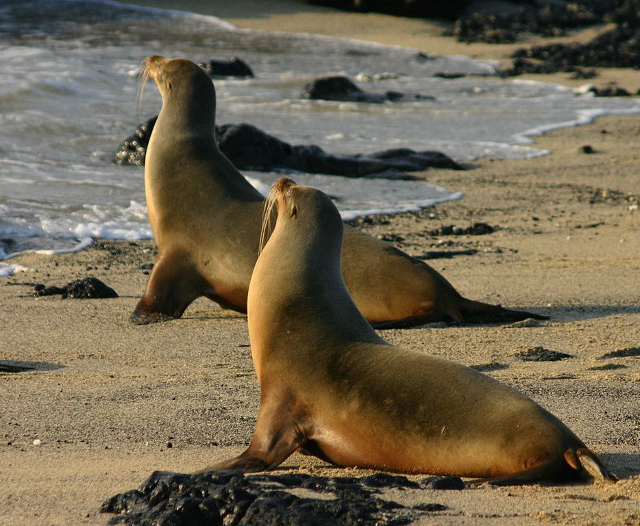
Unlike its sister island Santa Cruz, Isabela lacked the urban appeal, enticing you instead with its laid-back beach town charm. Sandy streets…palm trees rustling in the sea breeze…endless stretches of shoreline for swimming and surfing…Isabela was the perfect blend of adventure and relaxation. We found a great home base at the bright-pink Caleta Iguana, a hotel and surf camp located at the far end of the beach. For $80/night, we splurged on a two-room suite with private bath and an ocean view; for the more frugal, bedrooms with shared baths started at $15/person. Nothing better than winding down from the rigors of the day, lazing in a hammock under a cabana, watching a game of beach volleyball. Well, sipping on a 2-for-$5 frozen strawberry daiquiri during happy hour, watching the sun sinking behind the clouds lingering in the highlands…that might be better.
With such a convenient location on Isabela, we were easily able to arrange all of our tours through the services of our hotel. Junior kept us on schedule–whether that meant securing the bicycles ($10/person) for our 5-hour ride to el Muro de Las Lágrimas (Wall of Tears), finding us a boat captain for the snorkeling tour ($60/person) through Los Túneles (the Tunnels), or pointing us in the right direction towards the free swimming hole at Concha y Perla lagoon.
Water excursions
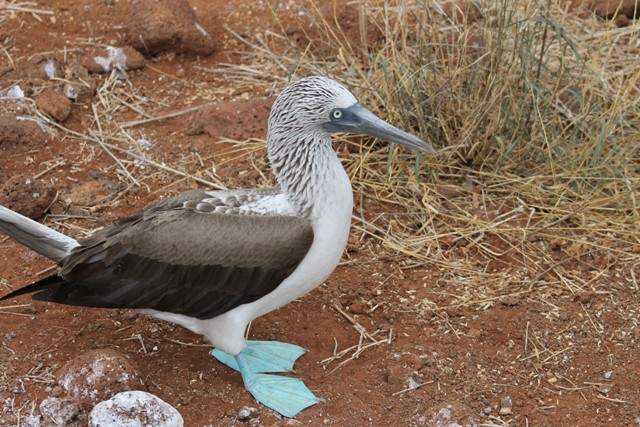
After every day of intense physical exertion, I would schedule a relaxing, chill-out-in-the-ocean snorkeling tour. And there was none better than Los Túneles, a tranquil oasis 60 minutes by speedboat from Isabela’s main pier – Puerto Villamil. Even the scenery en route was spectacular, out on the open ocean. Rayas (manta rays) glided through the water, occasionally propelling themselves into the air; we were nearly blinded by the shimmer from their bright-white undersides. Armor-plated sea turtles swam by, then a pair of dolphins.
At Roca Union (Union Rock), a gargantuan boulder jutting out of the ocean for no apparent reason, we spied flocks of Nazca and blue-footed boobies nesting on the upper tiers. Crabs near the water line scrambled into narrow cracks in the lava rock, dodging the fierce waves that relentlessly pelleted the stone’s face with saltwater spray. Los piqueros enmascarados (masked boobies) ignored the raging sea, content to clack-clack-clack their beaks at one another in a sort of animated conversation. They were attired like penguins–in only black-and-white–with raven tail feathers and wing tips, and an ink-colored circle drawn around their face. We laughed as they yammered back and forth…we laughed with our cameras in hand.
The boat continued onward, to the tricky entranceway guarding the rock archways of the Tunnels. A skilled captain, Leonardo eased the dinghy through the pounding surf, into the quiet, crystal-clear waters. “Reminds me of a ride through Disneyland,” commented Elizabeth Abrahams, a teacher from San Francisco. Disneyland in the middle of the Pacific. With turquoise waters and surreal landscapes of mangroves and desert cacti…alongside bleached lichens clinging to half- submerged arches of volcanic stone.
We jumped into the cold current, snorkels and fins all askew, and began exploring the coral reefs blooming in the clear water below. Chocolate chip starfish, seahorses, parrotfish…we pointed and giggled like school kids. An inquisitive lobo marino (sea lion) breezed by in a flurry of bubbles. Then another. We were surrounded by the impish clowns. The lions tucked and rolled, inches from our masks, before darting around the rear of the dinghy near the anchor.
We finished up our foray in the water with a couple of passes through the hardened lava rock tunnels that were completely immersed. Leonardo was right there, for those of us who needed a bit of a push to guarantee we made it through. El capitán guided the vessel carefully amongst the archways, some skulking just beneath the rudder. Past rock bridges lined with Candelabra cactuses…past squawking Galápagos penguins, hoping for a fishy hand-out…past unconcerned blue-footed boobies plumping their feathers in the ocean breeze. Los Túneles…an enclave of tranquility in the midst of a tempestuous sea.
They have volcanoes, too!
Rested and refreshed, we were ready for the third day’s excursion on Isla Isabela–the arduous climb to the crater of Volcán Sierra Negro and its sidekick, Volcán Chico. For $35/person, we had the pleasure of trekking uphill, through trenches of mud, across fields of lava rock that crunched like clay pottery underfoot and were capable of flaying the flesh from your limbs like a sharpened fillet knife. I’m not going to lie – to hike ten miles under these conditions in five hours is a grueling task, especially if you’re like us and not exactly what you’d call “in peak physical condition.” We may have always been the two lagging behind the pack, bringing up the rear, but my husband and I still made that difficult ascension and saw a spectacular sight.
El cráter at Sierra Negra, second largest in the world behind Ngoro Ngoro of Tanzania, was a soup bowl-shaped abyss of green-and-black. The green came from the tropical foliage that covered every inch of the crater’s walls, borne of the perpetual moisture from the highland mist. Black soot carpeted the mouth of the volcano, with only a rare stippling of verdigris from a struggling seedling purged from the ash. Steam vented from rifts in the caldera.
At Volcán Chico, the panorama was infinitely more colorful, and variegated. Foul-smelling emissions of sulfuric gas dissipated into the unpolluted air–fumaroles from the magma still roiling at the volcano’s core. Petrified layers of cooled lava, striated in shifting hues of beige, ocher and grey, dappled the landscape. Thorn-riddled cacti–endemic Cactus Candelabros trees–reached towards the heavens with stickery, outstretched limbs. An infrequent fruit blossomed on the spiny hands. We clambered along the rock-strewn trail, serpentining between the smaller mounds and the looming mountains of cooled lava, to the summit. We devoured our sandwiches like hungry wolves, delighting for a half hour in the whipping winds that threatened to snatch the very locks of hair from your head, but offered a welcome respite, nonetheless, from the afternoon heat.
For those of you a bit “out of shape” and no longer in your twenties or thirties, the last couple of miles on the hike back, your feet and your muscles are going to remind you that you’re not a spring chicken anymore…so will trying your best to hurry, while fighting to maintain your balance walking downhill over patches of slick mud. Word of advice: only brave this trek in quality hiking boots. Tennis shoes just won’t do. You’ll end up, like us, tossing them in the trash can back at the hotel. Ruined.
Los Tintoteras
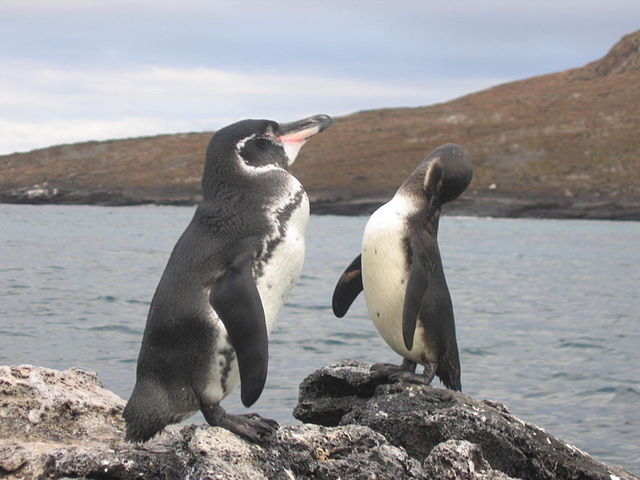
The next day we departed from the Puerto Villamil pier, for the nearby island of Los Tintoreras. Named for the white-tipped reef sharks that come there to nap in the quiet crevasses, the barren island is also official nesting territory – for las iguanas marinas (marine iguanas). The eggs are laid on the fine white sand near the shoreline. Easy pickins for the boobies and gulls that circle overhead. I could imagine the poor infantile iguanas, straining to free themselves from the confines of that shell, only to be plucked off the beach before they could even begin to scuttle the few treacherous yards across that sand to their sanctuary in the lava rock. Nature’s life-saving camouflage. Until then, the juvenile iguanas were as visible to the circling predators as bacteria growing in a Petri dish.
My heels groaned as I stumbled over the slag along the footpath. More sea lions – some snoozing, one chasing a stick at the water’s edge…Zapayas crabs…penguins…the Galápagos’ display of magnificent wildlife. Once more, we donned our snorkel gear and jumped into those cooling tides. For $25/person, Los Tintoreras was a welcome reprieve for my ailing limbs.
I played the last two weeks over and over again in my mind, reminiscing fondly about all the grand adventures I’d have to tell when I got back home. Tap dancing with the boobies on the only day-cruise we’d splurged on – to Seymour Norte for $145 a piece…admiring the overinflated, scarlet gular sacs of the male frigate birds overtly signaling their desire to find a mate…remembering that tourist with the camera on a retractable rod who scared the daylights out of a golden land iguana, only to have the daylights scared out of him from the Park Ranger’s wrath…lying down in the sand like beached whales, right next to a pair of sleeping lobos marinos for a photo op. All those things – they were worth the $5 grand we’d shelled out for our Galápagos vacation. In fact, you couldn’t put a price tag on those kinds of memories. I laughed at my husband and son up ahead, writing silly sentences in the wet sand, whispered, “bye, buddy” to one last marine iguana splayed unimaginatively out on a patch of beach grass, and set a course back to the mainland of Santa Cruz.
Expenses for the above trip to the Galápagos for 2 adults and 1 child:
Airfare
- Miami to Baltra, with overnight stop in Quito, Ecuador, then morning stop in Guayaquil on Lan Ecuador and on to the Galápagos via Aerogal
Airfare total: $2150
If you want to see more than just the Galapagos, consider building a multi-stop trip on Indie that includes both the Galapagos and a trip to Machu Picchu. Register for a BootsnAll membership to build, price, and book your next big trip!
Hotels
- Quito – 1 night – Hostal Marsella in downtown – $22 plus $20 roundtrip cab fare
- Isla Santa Cruz – 7 nights – Apartment (one bedroom with double bed and 2 bunk beds, kitchen and private bathroom) – located next door to Almacen d’Pily, secured through Jennifer Cumming/travel agent – $40/night
- Isla Isabela – 6 nights – Caleta Iguana Hotel and Surf Camp – $80/night for a two-room suite with private bath (Plus $5/person entrance fee to Isabela Island)
Accommodation total: $817
Galápagos National Park Fees
- $10/person Ingala fee, paid at Guayaquil Airport
- $100/person entrance fee, paid at Baltra
Total: $330
Transportation to Islands
- Bus from airport to Baltra ferry – Free
- Baltra ferry to Santa Cruz wharf- $.80/person
- Bus fare from wharf to Puerto Ayora – $1.80/person
- Taxi from Bus station to Apartment – $1
- Multiply x2 for round-trip fare to airport – note: we took a highlands tour upon arrival, thus bypassed all incoming fees from airport, as it was included in our price – see below
- Outbound Total: $8.80
- Ferry from Santa Cruz to Isabela – $30/person
- Ferry from Isabela to Santa Cruz – $30/person
Transport total: $180
Tours
- Highlands Taxi Tour – Sights: Los Gemelos Twin Craters, Free-roaming land tortoises at Rancho Primisius, and Lava Tunnels at Bellavista, plus transportation from airport to hotel – $35 plus 3/person entrance fee at Rancho Primisius for a total of $44.
- Note: EXPECT to get MUDDY in the tunnels, so if you’re coming from the airport, DON’T wear your good clothes. There’s one spot so low you have to crawl…and it’s muddy.
- Pineapple Plantation Tour – Guayabillos, Santa Cruz Island – Tour of working pineapple plantation with lava tunnel, includes all-you-can-eat BBQ and pitcher of fresh-squeezed passion fruit juice at Parillada Los Guayabillos Restaurant – plantation tour MUST BE booked through Jcumming@explorerventures.com – Restaurant open to the general public Sundays only 2:00 – 4:00 p.m. – Includes $5/each way taxi fare for a total of $31.
- Las Grietas – Santa Cruz Island – Swimming hole of brackish water for snorkeling practice – Access rocks are very slippery and very sharp (lava rock) – wear CLOSED TOE shoes/sandals – FREE – only fee is the $.60 taxi road across the bay to Finch Bay Hotel pier for a total of $1.80.
- Day Trip to Seymour Norte Island aboard Queen Karen – Highlights include tour of island to see land iguanas, Magnificent frigate birds, blue-footed boobies; snorkeling near island to see sharks resting on ocean bottom, sea turtles, rays, sea lions, and colorful fish; visit to an island of nothing-but-sea-lions for up-close interaction with the sublime creatures. – $145/person, includes lunch and snorkeling equipment – booked through Jcumming@explorerventures.com. Expensive, but WORTH EVERY NICKEL. If you can only afford one of the day trips, take this one. They all cost about $150/person OR MORE. We opted just to do this one, to fit the limits of our budget. *Note: Bring your own snorkeling gear from home. Much cheaper than renting which costs about $15/person/day for a total of $435.
- Charles Darwin Research Center – Santa Cruz Island – Educational tour of breeding center to see giant tortoises and land iguanas. Free.
- Rent bicycles – Ride to el Muro de Las Lágrimas (4-5 hours) – Isabela Island – Sandy/gravel trail from edge of town to the Wall of Tears – round-trip WITHOUT stopping at all the detours, about 12 miles; WITH detours, about 16 miles – $2/hour/person – booked through our hotel, Caleta Iguana for a total of $30.
- Los Túneles – Isabela Island – Speedboat tour to The Tunnels, a tranquil area of half-submerged rock archways. En route, at Union Rock, expect to see Masked and Blue-footed boobies, plus penguins. Snorkeling included. $60/person, including lunch – booked through hotel Caleta Iguana for a total of $180.
- Hike to Sierra Negra and Volcán Chico – Isabela Island – Difficult 10-mile trek to huge volcanic crater and its sister volcano for spectacular panoramas. Steam vents and fumaroles visible. – $35/person, including lunch, booked through our hotel, Caleta Iguana for a total of $31.
- Los Tintoreras – Isabela Island – Speedboat tour to Tintoreras Island to see white-tipped reef sharks, penguins, boobies, sea lions, and nesting colonies of marine iguanas. – $25/person, including snorkeling and snack, booked through our hotel, Caleta Iguana for a total of $75.
- Concha y Perla Lagoon – Isabela Island – Swimming hole great for snorkeling with sea lions and perhaps a sea turtle or penguin. Located next to Puerto Villamil pier. Free.
- Tortuga Bay – Santa Cruz Island – Follow the walkway to main surfing beach, then around the bend to a nice swimming area. Popular with the locals. Great chance to view GIGANTIC marine iguanas in their natural habitat, lazing on the sand in the sun. Not much to see for snorkeling, but pretty swimming hole. Long walk from town, so splurge for the $2 taxi ride. Otherwise, it’s free. Total was $2.
Grand total of tours, including $30 for tips: $933.80
Food
- Santa Cruz – I allowed $4/breakfasts, $6/lunches and $7/dinners per person. There are many eating establishments on Charles Binford Street that average $5-7/person, like Chifa Asia, Servi Sabroson and RosyMar Restaurant. For $5 seafood soups, try El Pulpo Cevicheria for their specialties: maremoto or encebollada. Platters of chicken or beef with rice, beans and salad (called Plancha de Pollo or Plancha de Carne) run about $7.
- Isla Isabela – Since I booked a package deal through our hotel, Caleta Iguana, including all the tours and the food, I paid the following prices: $3.50/breakfast, $7/lunch and $7/dinner per person. Our breakfasts were taken at the hotel–nowhere else on the island could you buy ala carte breakfasts of coffee, hot chocolate, fresh-squeezed juice, toast with butter and marmalade, and a bowl of papayas and bananas for $3.50. Our lunches and dinners were served at Cesar’s, one of the tastiest places in town. You could actually purchase their lunch or dinner SPECIAL of the day, including fresh juice, for $5/person, so it could be priced better on your own, than through the hotel. Just remember: anything other than the SPECIAL of the day will be pricey, anywhere on the island. This is a small fishing community, after all. That being said, expect to eat FISH, FISH, and more FISH.
Total: $571.50
Note: We spent lots more on food on Isabela, for snacks, and numerous ceviche ‘runs’ for Gustavo and Nicolas, etc., but made up for the difference by cooking a couple of dinners to save money on Santa Cruz. Buying fish (wahoo, albacore or swordfish) at the wharf on Santa Cruz at $2/kilo (2.2 lbs.) was a cheap way to get a lot of meat, at a bargain price.
Drinks
Allow plenty of extra bucks for drinks – water, mostly. The tap water is NOT for consumption, so you’ll need lots of bottled water. Plus, it’s hot, so you’ll need plenty. We brought a PUR water filter from the house, so we were able to convert tap water into usable water. Only bad point: even filtered, the tap water tastes TERRIBLE. Three liters of water or soda cost $2. If you have the good fortune of staying at an apartment that has the large blue water containers, you can exchange them for $5. Again, you might want to filter that water too. It tends to taste like perfume. Still, it’s great for cooking, teeth brushing, doing dishes and making coffee.
As for alcohol drinks, it depends on if you’re a big drinker or not. We’re not. We splurged a couple of evenings, during Happy Hour from 5:00-8:00 p.m., on the 2-for-$5 daiquiris and shots at our hotel.
Total before souvenirs: $4991.10
Souvenirs
I bought a three-dimensional ceramic frigate bird picture at the Green Reef Gallery for $110; a land tortoise picture frame for $25, a sea lion carving for $20, and several $10/apiece tote bags at el Mercado Artesanal, only open in the evenings on Santa Cruz; two painted ceramic sea turtle scaulptures for $50; a $50 coffee-table hardbound book and $20 video on the Galápagos, and other assorted ‘stuff’ to take home. Paid with credit cards at the galleries; not accepted at the Artisan Market.
Total: $400
Grand total of money spent on our trip: $5391
To find out more about traveling to the Galapagos, check out the following articles and resources:
- Read The Seven Animal Wonders of the Galapagos Islands
- Read 10 Activities for Animal Loving Travelers
- Check out Galapagos Adventure Trips
Photo credits: Charlesjsharp, frlgundi, PearlyV, Surtrek Tour Operator, all others courtesy of the author and may not be used without permission.
